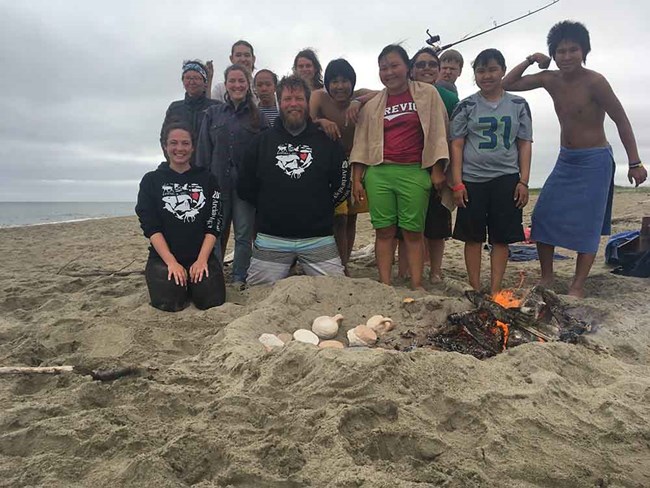Last updated: July 31, 2019
Article
Bering Strait Archaeology Camp, 2019

Nick Treinen
As the driftwood fire burns hotter and hotter, the group edges their handbuilt clay pots closer to the coals. A few steps away, a pair of teens gather beach greens to put the finishing touches on their model driftwood Qaġzri (sod gathering place). Behind them, driftwood poles and stones are staged in the sand to approximate a caribou drive, a historic method for directing a herd of caribou (in this case acted out by highschoolers wearing cardboard antlers) into a body of water where they could be more easily hunted. And, of course, back at the fire there are S’mores! These are all scenes from the 5th annual Bering Strait Archaeology Camp, held this July in Solomon with students from Koyuk, Nome, Brevig Mission, and Stebbins.
The camp—a partnership between Kawerak, the National Park Service, and Alaska Geographic and offered for credit through University of Alaska Fairbanks Northwest Campus—teaches students to combine archaeological methods like surveying house pit sites, analyzing artifacts, and interviewing elders to create a picture of the past. Making naniit (clay seal oil lamps) was a favorite activity of both the students and the instructors.
Other activities during the week of camp included an Ethnobotany presentation by Darlene Paqpaluk Trigg, a visit to historic village sites at Salmon Lake and Nuuk, a tour of Pilgrim Hot Springs, and hosting a niġipiaq dinner for elders with connections to the area around Solomon. Sandra Tahbone and family provided a fine dinner of reindeer soup, and Inupiaq salad.
Lisa Ellanna, director of the Katrivik Cultural Center and an organizer of the camp, explained that her wish for kids in the region to experience the science of cultural history. According to Caelie Butler of the National Park Service, the hands-on activities “build confidence and curiosity” while allowing students to “experience a direct, tangible connection to the past.”
The students’ final poster projects will be displayed at the Alaska Anthropological Association’s annual conference, held this year in Fairbanks.
